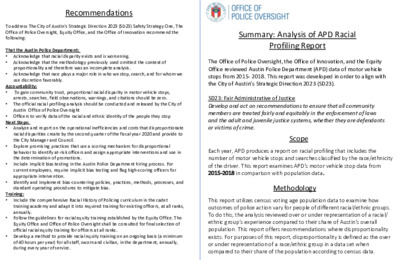2b_APD-Booklet_OPO_Table — original pdf
Backup

Recommendations To address The City of Austin’s Strategic Direction 2023 (SD23) Safety Strategy One, The Office of Police Oversight, Equity Office, and the Office of Innovation recommend the following: That the Austin Police Department: • Acknowledge that racial disparity exists and is worsening. • Acknowledge that the methodology previously used omitted the context of proportionality and therefore was an incomplete analysis. • Acknowledge that race plays a major role in who we stop, search, and for whom we use discretion favorably. Accountability: • To gain community trust, proportional racial disparity in motor vehicle stops, arrests, searches, field observations, warnings, and citations should be zero. The official racial profiling analysis should be conducted and released by the City of Austin Office of Police Oversight • • • Officers to verify data of the racial and ethnic identity of the people they stop Next Steps: • Analyze and report on the operational inefficiencies and costs that disproportionate racial disparities create by the second quarter of the fiscal year 2020 and provide to the City Manager and Council. Explore promising practices that use a scoring mechanism for disproportional behavior to identify at-risk officers and assign appropriate interventions and use in the determination of promotions. Include implicit bias testing in the Austin Police Department hiring process. For current employees, require implicit bias testing and flag high-scoring officers for appropriate intervention. Identify and implement bias-countering policies, practices, methods, processes, and standard operating procedures to mitigate bias. • • Training: • Include the comprehensive Racial History of Policing curriculum in the cadet training academy and adapt it into required training for existing officers, at all ranks, annually. Follow the guidelines for racial equity training established by the Equity Office. The Equity Office and Office of Police Oversight shall be consulted for final selection of official racial equity training for officers at all ranks. • • Develop a method to provide racial equity training on an ongoing basis (a minimum of 40 hours per year) for all staff, sworn and civilian, in the department, annually, during every year of service. Summary: Analysis of APD Racial Profiling Report The Office of Police Oversight, the Office of Innovation, and the Equity Office reviewed Austin Police Department (APD) data of motor vehicle stops from 2015- 2018. This report was developed in order to align with the City of Austin’s Strategic Direction 2023 (SD23). SD23: Fair Administrative of Justice Develop and act on recommendations to ensure that all community members are treated fairly and equitably in the enforcement of laws and the adult and juvenile justice systems, whether they are defendants or victims of crime. Each year, APD produces a report on racial profiling that includes the number of motor vehicle stops and searches classified by the race/ethnicity of the driver. This report examines APD's motor vehicle stop data from 2015-2018 in comparison with population data. Scope Methodology This report utilizes census voting age population data to examine how outcomes of police action vary for people of different racial/ethnic groups. To do this, the analysis reviewed over or under representation of a racial/ ethnic group’s experience compared to their share of Austin's overall population. This report offers recommendations where disproportionality exists. For purposes of this report, disproportionality is defined as the over or under representation of a race/ethnic group in a data set when compared to their share of the population according to census data. Key Findings Racial Disparities: In 2018, Black/African Americans were the most overrepresented of all racial/ethnic groups in motor vehicle stops. Searches: Not all searches require the same level of discretion of a police officer. Low discretion searches are searches in which the officer is required to conduct a search, such as in cases of arrest and towing. High discretion searches are cases when the officer decides whether to search an individual using their own discretion. These searches often involve consent, frisk for safety, probable cause, and contraband. Black/ African Americans were the only racial/ethnic group to face more high discretion searches than low discretion searches. Racial Disparity Trend: During this time period, Black/African Americans and Hispanic/ Latinos were increasingly overrepresented in motor vehicle stops, while White/Caucasians were increasingly underrepresented. Asians remained underrepresented. In other words, from 2015- 2018, the racial disparity gap in motor vehicle stops widened. Arrest vs Field Warnings : When looking at where arrests, warnings, and field observations took place, data also demonstrates geographical disparity. Commuter Data: Commuter data remains the same across race and cannot explain the reasons for certain race/ethnic groups being stopped more often than others. This table shows the number of people living in Austin who commute while driving alone.